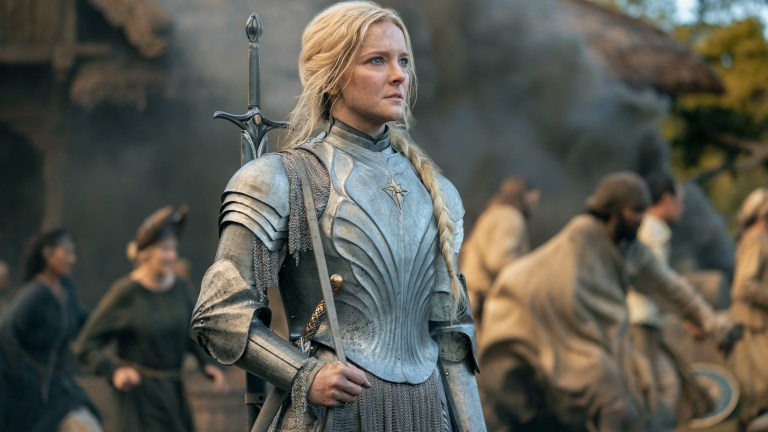Lord of the Rings: The Rings of Power Episode 6 Review – Udûn
The Southland goes to war in episode 6 of The Rings of Power.

This Lord of the Rings review contains spoilers for The Rings of Power.
The Lord of the Rings: The Rings of Power Episode 6
This episode is dedicated to one storyline that brings two of our four main groups of characters together: the Battle of the Southlands and its aftermath. Although split across three waves of Orc-led attacks and a Númenorean counter-attack, this is essentially one drawn-out battle. In between the first two phases of the battle, we also get some interesting moments between Galadriel, Isildur, and Elendil on their ship, but by their next scene they have arrived with the cavalry to join the fighting.
We don’t see anything of either the Harfoots or Elrond and the Dwarves. The Harfoots aren’t really missed from the story, other than it means the mystery of who the Stranger is will be dragged out for at least another episode. Elrond and Durin leave a bigger hole, as they, together with Disa, provide a lot of the series’ warmth and humor. Isildur’s funny friend Ontamo (Anthony Crum) only gets a few brief moments onscreen, so we miss Elrond and Durin’s warm banter. And the less we see of Celebrimbor, the further we are from actually forging any Rings of Power.
The title of the episode, “Udûn,” can refer to a couple of different things from Tolkien’s mythology. It is the name of one of Morgoth’s strongholds, also called Utumno, a particularly Hell-like place; and Gandalf referred to the Balrog of Moria as “Flame of Udûn.” It is also a valley in northern Mordor. Since the Southlands is the area that will become Mordor, it is probably the valley in which most of the episode takes place. That would make sense, as the episode ends with the flooding of the valley and a volcanic eruption. Presumably the volcano in question is Mount Doom, and its eruption will transform the land into the wasteland we see later. At some point, Sauron will forge the One Ring inside this volcano, although six episodes in, no one has even uttered the word “ring” yet.
The idea of devoting an entire episode to a single conflict was perfected, of course, by Game of Thrones with installments like season 2’s “Blackwater,” season 4’s “The Watchers on the Wall,” and season 8’s “The Long Night.” These in turn were partly inspired by the lengthy Battle of Helm’s Deep sequence in The Lord of the Rings: The Two Towers. But those sequences featured more actual fighting than this one does. In fact, the episode doesn’t quite seem to want to commit to the conflict-driven setting, breaking up the pace with quiet conversations about horses or trees, but it does bring the story into focus and provide considerably more plot movement than previous episodes, which have had to spread their runtime across more storylines.
This kind of pre-battle or mid-battle character work can be a really satisfying way to build up to a big death, but its effectiveness is a little bit limited here because we haven’t really spent quite enough time with these characters beforehand (perhaps excepting Galadriel) to really care if any of them die in battle. With four competing storylines, we barely know most of them, and none of the significant characters (Arondir, Bronwyn, Theo, Galadriel, Halbrand, Elendil, Isildur, Míriel, Adar) actually die anyway.
Ultimately, the battle resolves itself in a pretty predictable manner, with Númenor charging in to save the day just as all hope seems lost for the Southlanders. But there’s more to it than that. The final quarter of the episode is devoted to the aftermath of the fighting. We get a bit more information about Adar, but the biggest takeaway there is that he claims to have killed Sauron – which, of course, we know is not true, there are six movies that tell us so. He calls himself “Uruk” but he is an ancient Orc, not one of Saruman’s later Uruk-Hai – Saruman is not only still a good guy at this point in the story, he is not even on Middle-earth yet, and his Uruk-Hai could move in daylight.
We see quite a lot of Halbrand, and the final part of this episode certainly provides some ammunition for the Halbrand-is-Sauron theory. He is extremely angry at Adar, which would make sense if Adar had tried to kill him, and he asks if Adar remembers him. Adar asks who he is with some interest, and then he is hailed as King of the Southlands (right before the entire village is swept away). The actual destruction of the dam is carried out by the irritatingly-still-alive Waldreg, who could have been acting under orders from Halbrand, who might have been able to swap the sword hilt for an axe after helping Galadriel to recover it. But we still lean towards a different, Ringwraith-shaped fate for Halbrand (his character and actions just don’t seem to match what Sauron should be up to at this point), but it’s fair to say this episode provides plenty of hints that Halbrand might not be who he says he is.
There are some other effective moments in the episode. The discovery by the Southlanders that their own people are fighting with the Orcs against them is horrifying and well done, and Bronwyn talking Theo through her own medical treatment is appropriately wince-inducing as well. The action itself is decent enough, with Orc blood dripping into Arondir’s mouth an especially memorable image. Galadriel also introduces us to a new expression – “eat your tongue” instead of “bite your tongue” is rather good, and should make its way into everyday usage.
The sequence in which Galadriel chases down Adar and his evil sword hilt on horseback through the woods is a clear re-working of the famous – and brilliant – chase scene in The Fellowship of the Ring in which Arwen just barely escapes from all Nine Ringwraiths, all on horseback. Galadriel is even whispering the same word (“nurolîm” which is Elvish for “faster”) to her horse. It’s a nice call back, though it does make Halbrand’s solution to end the chase (knocking out Adar’s horse’s legs) a little bit underwhelming in comparison with Arwen’s (raising a river to sweep away the Riders).
Overall, the story is finally starting to really kick into gear. There are still occasional pacing problems – for example, we see the dam burst and water pouring down the valley, then we cut to a quiet scene of Isildur and Elendil having a chat about a horse. It completely destroys the feeling of peril and momentum produced by the scene of the dam breaking. We needed to see that conversation first, then cut to the dam, then cut back to spouts of water destroying the village. And there is the constant problem of its very nature as a prequel undercutting some of the series’ tension as well – seeing Galadriel apparently consumed by fire at the end of the episode isn’t a cliffhanger when we’ve seen her in six movies set centuries later.
Still, we are finally starting to see what The Rings of Power is really all about now, and get a sense of where this first season is going. If they can just settle the “mysteries” that are now starting to become annoying (is the Stranger Gandalf? Is Halbrand Sauron?) we might be looking at something with the potential to be really exciting.
